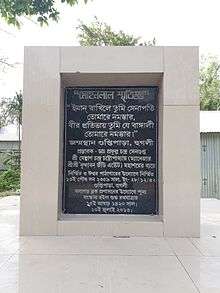Diwan Mohanlal
Diwan Mohanlal of Bengal (Bengali: মোহনলাল) was a Hindu bureaucrat who served as the Diwan of Siraj ud-Daulah, the Nawab of Bengal, at Murshidabad for a year from 1756 to 1757. His appointment was controversial due to his religion; The Nawab's decision of elevating Mohanlal to the prominent position of his supreme Diwan caused the Muslim nobility, and in particular Mir Jafar, to take great offense. Mir Jafar was then the head of the armed forces, second only to the Nawab, and the elevation of a Hindu to a post above him was taken almost as a personal insult.

On the day of 23 June 1757 in the Battle of Plassey, Siraj ud-Daulah faced off against the British, apparently with overwhelming force, but at the critical time Mir Jafar's men stood watching passively while the soldiers of Siraj ud-Daulah were decimated by the smaller but much better armed British forces. In the said 'so called' battle Mohanlal and his fellow leader Mir Madan fought on the side of the Nawab's Army.[1] After the death of Mir Madan, he wanted to attack the British army rapidly and advised Siraj ud-Daulah that the decision of retreat may be fatal for the Nawab. But the Nawab was already misguided by Mir Jafar did not consider Mohanlal's opinion.
Mohanlal was born in early eighteen century in a royal maithili karna kayastha family of Purnea. He married Nawab Siraj ud-Daulah's younger sister Shahzadi Afseen Begum; they had two sons and a daughter: Raja Sreemant Lal, Hukka Lal and Galibunnessa. Raja Mohanlal was appointed "Peskar" by Nawab Siraj ud-Daulah on 16 April 1756 and conferred "Maharaja" after Manihari War on 16 October 1756.
An apocryphal story without any proof is that of a sister of Mohanlal. The story goes that he had a younger sister, Madhabilata, who was kidnapped by the Portuguese in a rebellion during her childhood. When she grew older, she was appointed as dancer or tawaif by Mir Jafar, who renamed her as 'Faizi Bai'. And sent her to secretly spy on the Nawab under a deal with East India Company wherein she was to be handsomely paid if she could assassinate the Nawab. It's said that the Nawab suspected that Faizi was a spy, but didn't confront her on it and let her continue in his court as 'Alia'. This saddened Siraj's wife Lutfunnisa Begum, which made the Nawab arrest Alia; Mohanlal did not protest as he seemed to suspect her ulterior motives or perhaps because of his strong loyalties with the Nawab
Mohanlal's son-in-law Bahadur Ali Khan was killed on 23 June 1757 in the battle of Plassey and his elder son Raja Srimanta Lal of Purnea was killed by order of Miran, son of Nawab Mir Jafar. He and his younger son Hukka Lal took up refuge in Juranpur Kali Pith in the Nadia district of West Bengal.
In popular culture
Mohanlal has been portrayed as a great patriot and the most trusted lieutenant of the nawab in the famous Bangladeshi movie Sirajud Daulah as well as in Indian movie Ami Sirajer Begum. Bengali poet Nabinchandra Sen also symbolized his heroic resistance in his poem Palashir Juddho and in the drama of Sachindranath Sengupta Sirajudullah.
Myth
It was stated that after the defeat of the battle of Plassey he fled to Mymensingh to save Siraj's child from the henchmen of Miran. Later he took shelter in different places of Bengal such as Juranpur village Kali temple, a Shakti Peetha of Nadia district and Brindabanchandra Mandir at Guptipara, Hooghly. Few sources referred that Guptipara is the birthplace of Diwan Mohanlal.[2]
References
- Part I, Narayan Sanyal (1990). Rupmanjari (Bengali). Kolkata: Dey's Publishing. pp. 485, 489.
- Amalendu Dey (2012). Sirajer putro o bangsadharder Sandhane (Bengali). Kolkata: Parul Prakashani Pvt. Ltd. pp. 42, 49. ISBN 9789382300472.
- "Riyazu-s-salatin", A History of Bengal, Ghulam Husain Salim (translated from the Persian): viewable online at the Packard Humanities Institute
- Mir Jafar in the Banglapedia
- Yadavs of Indian (2009, English Edition) by Dr. Swapankumar Ghosh, Kolkata, published by Pandulipi Pages 133-135. ISBN Number: 978-93-83895-39-7